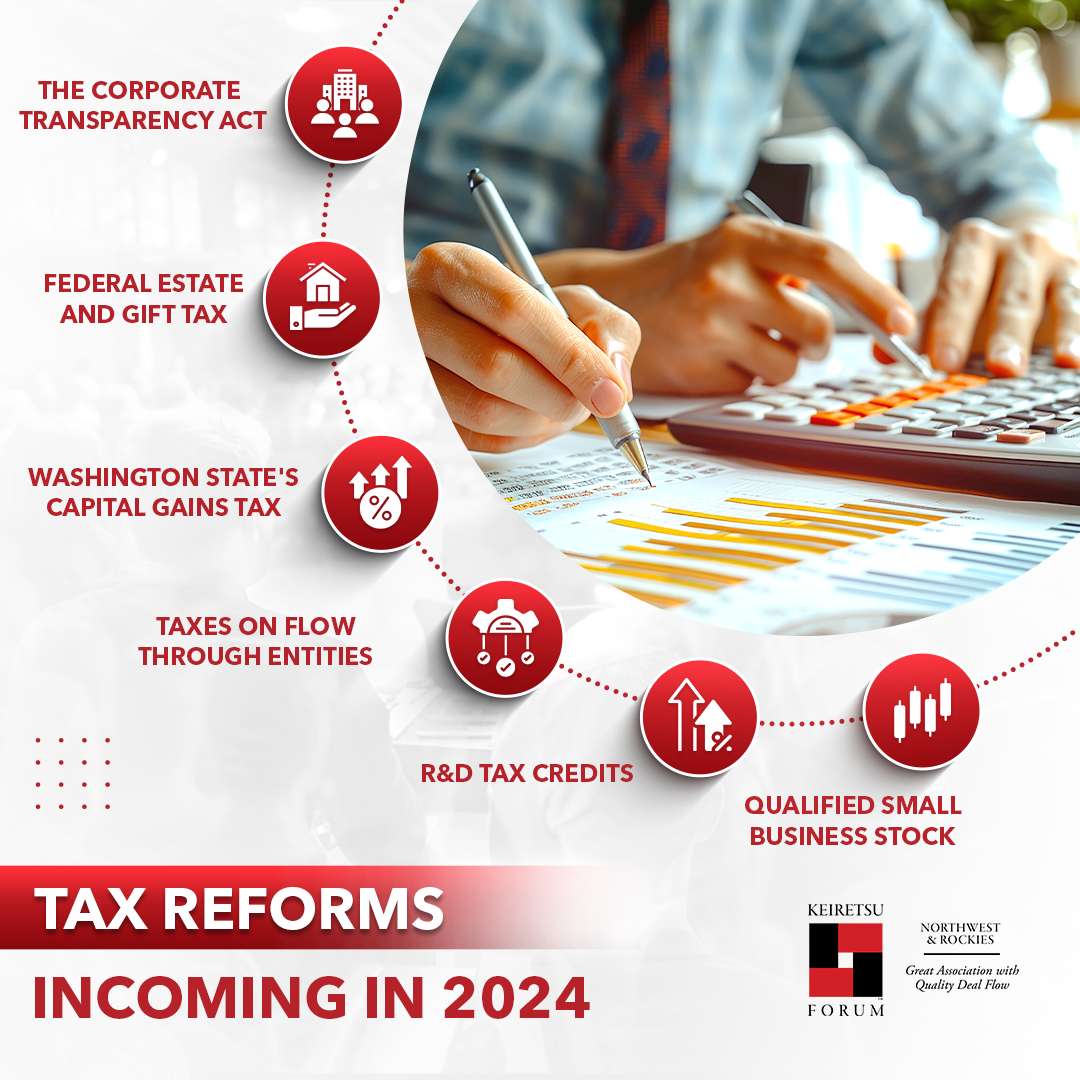
2024 might seem like a relatively quiet year in the world of taxes, but it's just the calm before the storm. Major tax changes are on the horizon, with significant implications for investors. To navigate the upcoming tax landscape successfully, it's crucial to understand the potential impact these changes will have on your personal and financial situation. In this blog, Brian Parsons and Christopher Cress highlight the most important tax changes on the way in the coming months and how they will impact your finances.
Upcoming Tax Changes in 2026: What to Expect
As we approach January 1st, 2026, several significant tax changes are set to take effect unless new legislation is enacted. Here's a breakdown of the key changes that individuals and businesses should prepare for:
Corporate Tax Rates
The current 21% tax rate for C-corporations, reduced from 35%, is a permanent change. This means C-corporations will continue to benefit from this lower tax rate beyond 2025, making them an attractive option for certain investments.
Individual Tax Rates and Brackets
The individual marginal tax rates are set to revert to pre-2017 levels. The top tax rate will increase from 37% to 39.6%. While this may seem like a minor change, the impact is more pronounced due to adjustments in income brackets. The brackets determining how income is taxed at various rates will shrink, potentially increasing the tax burden for those earning between $100,000 and $200,000.
The standard deduction will decrease, which may lead more taxpayers to itemize their deductions. This change will reinstate the ability to deduct certain expenses on Schedule A, such as investment and unreimbursed business expenses. Additionally, tax compliance expenses will become deductible again.
State and Local Taxes
The cap on state and local tax (SALT) deductions, currently limited to $10,000, will be removed. This change will particularly benefit taxpayers in states with high-income taxes, as they can deduct the full amount of their SALT.
Qualified Business Income Deduction
The 20% qualified business income deduction for flow-through entities like partnerships and S-corporations will be eliminated. This deduction was initially introduced to maintain parity with the reduced corporate tax rates, and its removal will affect many businesses that are not structured as C-corporations.
Net Operating Losses
Companies will regain the ability to offset 100% of their income with net operating losses (NOLs) and carry them back to prior years, reversing the current limitation to 80% of income.
Estate Tax Deduction
The increased estate tax deduction will be reduced, impacting estate planning strategies. Individuals who have not yet engaged in estate planning should consider doing so before the deduction decreases.
These changes highlight the importance of strategic tax planning as we approach 2026. Individuals and businesses should consult with tax professionals to understand how these changes may impact their financial situations and to explore potential strategies to mitigate increased tax liabilities.
2024 Tax Law Changes
The Corporate Transparency Act and Beneficial Ownership Reporting
The Corporate Transparency Act (CTA) has introduced a significant shift in the reporting requirements for businesses operating in the United States. Effective January 1, 2024, the Act mandates companies disclose beneficial ownership information to the Financial Crimes Enforcement Network (FinCEN). This initiative aims to enhance transparency in business ownership and combat financial crimes by identifying the individuals who ultimately own or control entities.
Who Must Report: Both foreign and domestic entities registered to do business in the U.S. are subject to this requirement. This includes various business structures, such as corporations, limited liability companies (LLCs), and other similar entities. While some exemptions exist, most entities that previously did not have to report will now need to comply.
Reporting Deadlines: Businesses already operating in the U.S. must report their beneficial ownership information to FinCEN by the end of 2024. Entities created in 2024 must report within 90 days of their formation. Starting in 2025, new companies will have 30 days from their formation to report.
Penalties for Non-Compliance: The CTA imposes significant penalties for failing to report beneficial ownership information:
-
Civil Penalties: Non-compliance can result in fines of approximately $600 per day, adjusted for inflation, up to a maximum of $10,000.
-
Criminal Penalties: More severe consequences include potential criminal charges, with penalties reaching up to two years in jail.
Why This Matters: By requiring disclosure of beneficial ownership, the U.S. aims to prevent illicit activities such as money laundering and tax evasion. Even small and inactive entities, including LLCs commonly used by investors, must comply with these reporting requirements. This means that many business owners who might not have previously considered this requirement will need to take action.
Federal Estate & Gift Tax Exemptions: A Crucial Window Before 2026
The Tax Cuts and Jobs Act brought significant changes to gift tax exemptions, allowing individuals to shield a substantial portion of their estate from federal taxes. However, these provisions are set to sunset at the end of 2025, dramatically altering estate planning strategies. Here's what you need to know about the upcoming changes and how to prepare.
Current Gift Tax Exemptions: Individuals can pass on approximately $14 million through their estate without incurring the 40% federal estate tax. For married couples, this exemption can reach up to $27 million. This presents a unique opportunity to transfer wealth across generations while minimizing tax liabilities.
As of January 1, 2026, the exemption levels will be cut in half, dropping to about $7 million per individual. This reduction will significantly impact the ability to shield estates from federal taxes.
Implications for Estate Planning: With the current high exemption levels unlikely to be extended, individuals with estates exceeding $5 to $7 million should consider consulting with an estate planner as soon as possible. Estate planners are already experiencing high demand, and waiting until the last minute could result in missed opportunities to optimize estate plans.
In addition to federal taxes, state-level taxes can further impact estates. For example, Washington state imposes an estate tax as high as 20%. However, gifts made during a person's lifetime are not subject to this state tax, offering a strategic advantage for reducing overall tax burdens.
Understanding Washington State's Capital Gains Tax
Washington State's capital gains tax remains a polarizing issue, with significant implications for residents and potential ripple effects for other states. Whether you're a resident of Washington or simply interested in tax policy, this situation is worth monitoring closely.
While many residents may already be familiar with its requirements, the tax faces legal and public challenges. Here's an overview of the current state of the capital tax and its potential implications.
Current Requirements and Exemptions: Washington taxpayers must report their long-term capital gains to the Department of Revenue. The tax does not apply to short-term capital gains. The tax includes a $250,000 standard deduction. Additionally, taxpayers can receive a $100,000 deduction if they donate $350,000. Credits are also available to prevent double taxation on gains already taxed at the state or local business level.
Legal and Public Challenges: The Washington State Supreme Court has upheld the capital gains tax as constitutional despite attempts to repeal it. This has been a contentious point, as capital gains are typically considered income taxes in other states.
In November, Initiative 2109 will be on the ballot, offering voters the chance to repeal the tax. This marks the third attempt to remove the tax, reflecting ongoing public division.
Broader Implications: Washington's classification of capital gains as an excise tax rather than an income tax sets a precedent that could influence other states without income taxes, such as Nevada, Florida, Texas, and New Hampshire. This reclassification could potentially lead to similar measures in these states.
With the tax deemed constitutional, cities like Seattle are considering additional local capital gains taxes, potentially adding 1% to 3% to the state tax. This could result in a combined rate of up to 10% on capital gains.
Economic and Social Impact
The tax has prompted some residents to relocate to avoid the additional financial burden. The decision to move is influenced by the fact that the tax applies based on residency at the time of the gain, not when the income was earned. The tax is often viewed as a levy on the wealthy, but opinions are mixed. Some consider it an unfair burden, while others consider it a necessary revenue source. The upcoming vote will be a critical indicator of public sentiment.
Navigating the Impact of Tax Changes on Flow-Through Entities
The anticipated changes to the qualified business income deduction highlight the need for strategic investment planning. Investors should closely monitor legislative developments and consider diversifying their portfolios to include C-corporations, which may offer more stable tax benefits.
Current Advantage of Flow-Through Entities: Right now, investors in flow-through entities such as partnerships and S-corporations benefit from a 20% qualified business income deduction. This deduction effectively reduces the taxable income from these investments, enhancing after-tax returns.
Potential Changes and Their Impact: If the 20% deduction is eliminated, as is set to happen at the end of 2025, unless legislative action is taken, investors will lose a significant tax advantage. This change primarily affects small businesses and their investors, as the deduction was designed to create parity with the lower corporate tax rates.
Without the deduction, the effective tax rate on income from flow-through entities will increase, potentially reducing the attractiveness of these investments. This could lead to reassessing investment strategies, particularly for those heavily invested in small businesses.
Strategic Considerations for Investors: Given the potential loss of the flow-through deduction, investors might consider shifting their focus to C-corporations. With a permanent corporate tax rate of 21%, C-corporations may offer more predictable and potentially favorable tax treatment for dividends and other distributions.
Investors should compare the after-tax returns of C-corporations versus flow-through entities. While flow-throughs have been advantageous due to the deduction, the landscape may shift if the deduction is removed.
Leveraging R&D Tax Credits: A Key Strategy for Early-Stage Investors
Investing in early-stage companies requires a keen understanding of all available financial tools, including R&D tax credits. This credit benefits startups, allowing them to offset up to $500,000 in payroll taxes. This can provide substantial cash savings, which is vital for early-stage companies focused on innovation and development. By ensuring that startups are leveraging these credits, investors can improve their investment returns and support the growth of businesses.
The recent relaxation of the IRS's documentation requirements further underscores the importance of these credits and presents an opportune moment for investors to reassess their strategies. In 2022, the IRS introduced more stringent documentation requirements for claiming R&D tax credits, making it more challenging for companies to qualify. However, these requirements were recently relaxed, easing the burden on startups and making it easier to claim these valuable credits.
The IRS has acknowledged that the 2022 changes were overly burdensome and has since simplified the process. The changes include removing the need to provide detailed information about individuals involved in research activities and the specific discoveries sought.
Investors should actively engage with the startups they invest in to ensure they take full advantage of the R&D tax credits. The stakeholders should determine if they are eligible for the credits and how they can effectively utilize them to offset payroll taxes. The ability to offset up to $500,000 in payroll taxes can significantly impact a startup’s cash flow, providing more resources for growth and development.
Exploring the Benefits of Qualified Small Business Stock
Qualified Small Business Stock (QSBS) remains a powerful tool for investors looking to maximize their returns while minimizing tax liabilities. By understanding the requirements and potential benefits, investors can make informed decisions about their investments in C-corporations. Here’s a closer look at what QSBS entails and why it’s an attractive option for investors.
Key Benefits of QSBS:
-
Exclusion Limits: Investors can exclude up to $10 million or ten times the stock's adjusted basis from capital gains taxes on qualified investments. This exclusion applies to federal taxes and can significantly reduce the tax burden on successful investments.
-
Tax Exclusions: QSBS allows investors to exclude the 3.8% net investment income tax. Washington residents are also eligible for this treatment, so they do not have to pay the 7% long-term capital gains tax that does not apply to QSBS. The savings can rise to 30%, translating to over $3 million in potential advantages if the $10 million exclusion is maximized.
Current and Future Outlook: Despite the significant benefits of QSBS, the IRS has not provided detailed guidance or taken a firm stance on certain aspects, such as treating SAFEs. No recent tax law cases have addressed these issues, leaving some uncertainty in applying QSBS rules.
As of now, there are no active proposals to eliminate QSBS benefits, but investors should stay informed about potential legislative changes that could impact these advantages.
QSBS Strategies for Short Holding Periods
If you have QSBS that you haven't held for the full five-year period, you can potentially roll over the gain into another QSBS investment. This strategy allows you to continue the qualifying timeline and maintain eligibility for the tax benefits.
Steps to Roll Over QSBS Gains:
-
Identify a New QSBS Investment: The new investment must also qualify as QSBS, meaning it needs to be in a C-corporation that meets the necessary criteria.
-
Repurchase Timeline: You must reinvest the proceeds into the new QSBS within 60 days of selling the original stock.
-
Minimum Holding Period: You must have held the original QSBS for at least six months before selling it.
-
Continue the Holding Period: By reinvesting in another QSBS, you can continue the holding period from the original stock, eventually meeting the five-year requirement.
Getting The Most From Your Losses With Section 1244
Investing in startups and small businesses can be rewarding, but it also comes with the risk of loss. When an investment doesn't pan out, understanding how to leverage tax provisions can help mitigate financial setbacks. One such provision is Section 1244 of the Internal Revenue Code, which offers significant advantages for handling investment losses.
Understanding Section 1244 Stock: Typically, investment losses are treated as capital losses, which can only offset capital gains and are limited to $3,000 per year against ordinary income. However, Section 1244 allows qualifying losses to be treated as ordinary, providing a more substantial tax benefit.
Under Section 1244, you can claim an ordinary loss of up to $50,000, or $100,000 if filing jointly, in the year the stock becomes worthless. This immediate deduction can significantly reduce taxable income and provide substantial tax relief.
Qualifying for Section 1244 Treatment
The tax laws have a few criteria for individuals to qualify for the Section 1244 benefits:
-
Underperforming Stock: The stock must be in the negative in the year the loss is claimed.
-
Small Business Corporation: The company must qualify as a small business corporation when the stock was issued, with aggregate capital not exceeding $1 million.
-
Original Issuance: The stock must have been issued directly to the investor in exchange for money or property, not as compensation for services.
Given the specific requirements and potential benefits of Section 1244, it's crucial to work with a tax professional. They can help determine eligibility and ensure that you maximize the tax advantages of any investment losses. Maintain thorough records of the investment, including the original stock issuance and any transactions, to support the claim of a Section 1244 loss.
These are all the tax changes on the horizon you must be wary of. Feel free to speak to your tax consultant to better understand and adapt to these changes. Be prepared for these changes well in time before you end up paying more unnecessarily.
About The Speakers
Brian Parsons, Managing Member at R.D. Barnett PLLC, is a seasoned financial advisor with 20+ years of experience in wealth management and tax planning. He excels in crafting personalized strategies to optimize financial outcomes and guiding clients through complex financial landscapes.
Chris Cress is Tax Manager at RD Barnett, LLC, specializing in tax planning and compliance. With extensive experience advising clients on complex tax issues, he focuses on delivering tailored solutions to meet individual and business needs.
Watch their full keynote at Keiretsu Forum Tax Academy here.


